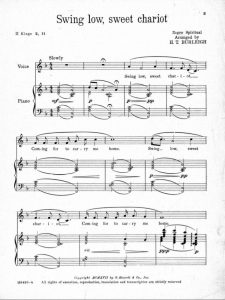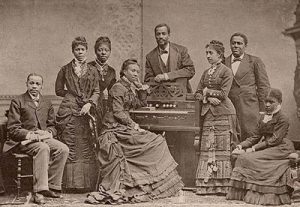We all know what a spiritual is, or at least have heard a spiritual being sung. That is because spirituals are identified in many different contexts; religious songs, folk songs, traditional songs, to name a few. When reading George Cullen Jackson’s article titled “White and Negro Spirituals (1943),”1 I was amazed to discover that “the white people once sang spirituals, and still sing them-some of the very same songs as those sung by the black folk (page 1)” at nearly the same time as each other.
“Traced the white man’s tunes back to a still more remote emergence, in the British Isles where possible and in a secular song environment. For I have felt sure that singers in the Old World would be fairly free, in those early times, from the suspicion of having been influenced by the singing of American slaves (page 265).”2
These “Old World” tunes, as he calls them, were transferred from the British Isles to America. However, many of these tunes also transformed into new spirituals with different meanings as before.

“Swing low, sweet chariot” Spiritual. This composition was arranged by H.T. Burleigh3
Take “Swing Low, Sweet Chariot”3 for example. Jackson’s studies discover that the ‘Bailiff’s Daughter” pattern linked from the British Isle can be heard in this Black American spiritual. Now this doesn’t mean that anyone is at fault for “copying” the work’s of other races with context to this scenario. I state this because even though these two tunes have similar structures and characteristics, they also have completely different sounds and meanings.
After listening to the recording of “Swing Low Sweet Chariot,”4 the first thing I realized is how different this sounds compared to a European religious spiritual. Where a catholic spiritual would likely be arranged in SATB singing structured chords resulting in a timed cadence, this recording not only consists of a male vocal group, but also elongates each chord as long as they felt was needed. The harmonies blend well into each other, and create a sort of African smoothness from their style. There seems to be no western classical notation instructed, because this spiritual wasn’t meant to be strict in the harmony or structure of religion in European context – regardless of the many different interpretations of the origins of this composition, all fall into the central theme of slaves being hopeful for days of freedom, whether that be freedom from slavery, or freedom into heaven.5
Over the centuries that this American tune has been circulating, many arrangements have been presented, like this video of The Tabernacle Choir singing the same spiritual.6 Over the centuries that this American tune has been circulating, many arrangements have been presented, like this video of The Tabernacle Choir. Notice how it is sung in a completely different style. This alteration gives light to different experiences of the vocalists, those who simply did not sing this spiritual out of hope for better days. This does not discredit any performance of this piece, but rather circles back to the original point being made that different races and backgrounds have and continue to sing the spirituals of other races and backgrounds to this day. Think of this as sampling: artists take old songs and material to shed new light on it, and create a whole new perspective. We can apply the same ideas to that of spirituals, instead of playing a constant “this versus that” when it comes to the music we listen to and perform.
1 Hustvedt, S. B., and George Pullen Jackson. “White and Negro Spirituals: Their Life Span and Kinship.” California Folklore Quarterly 4, no. 4 (1945): 265–89. https://doi.org/10.2307/1495642.
3 Burleigh, H.T., ed. “Swing Low, Sweet Chariot : Negro Spiritual. [High].” CONTENTDM. Accessed October 5, 2023. https://digital.library.temple.edu/digital/collection/p15037coll1/id/5403.
5 Anderson, Toni P. “Swing low, Sweet Chariot”—the Fisk University Jubilee Quartet (1909). Accessed October 5, 2023. https://www.loc.gov/static/programs/national-recording-preservation-board/documents/Swing%20Low%20article.pdf.


